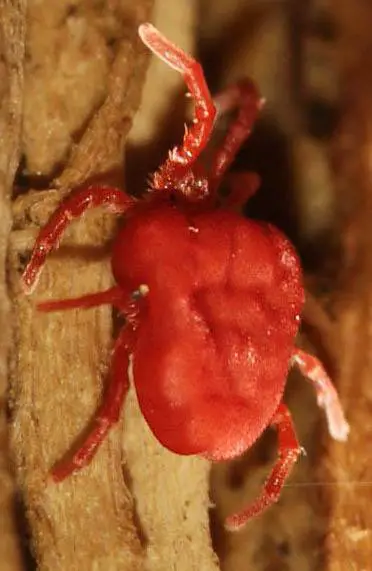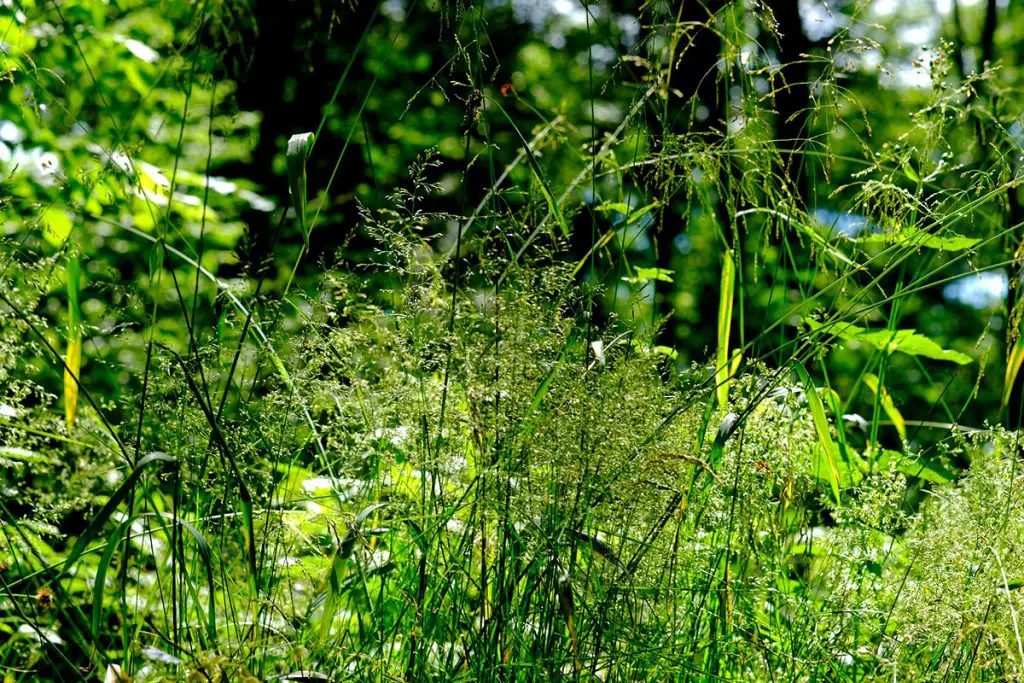Note: This post may contain affiliate links. Read full disclosure policy here.
If you’ve got some red bites and you’re wondering about identifying chigger bites, you’ve come to the right place.
While you may know right away where that mosquito bite came from, sometimes you get some red, itchy marks that are a total mystery.
Identifying what those bites are is critical to treating them properly and making sure you don’t get them again.
This article describes ways to distinguish chigger bites from other types of bites, amazing ways to treat chigger bites, and surefire ways to make sure you never get chigger bites again.
What are chiggers?
Believe it or not, but those little guys that cause so much suffering are just babies.
And that’s the reason you typically don’t see them – because they are babies. They are usually not visible to the naked eye, although you might see them under a magnifying glass. Typically, chiggers are usually around 1/150th of an inch or 0.3 mm.
Chiggers are juveniles of the mites Trombiculidae. They are actual arachnids, not insects. The adults are harmless but the babies are parasites…literally parasites – meaning they require a host to feed on in order to survive.
Because they are just babies, chiggers don’t travel far. They are found in clumps, not far from where they were hatched. That’s why you get many chigger bites at once.
Chiggers are sometimes called harvest mites, harvest bugs, harvest lice, mower’s mites, or red bugs. They are usually red but can also be orange, yellow or straw-colored.

There are over 10,000 species of chiggers around the world and they can be found in every country in the world. References to chiggers go all the way back to the sixth century in China. Most was learned about chiggers, though, because of the problems they caused during World War II.
Chigger bites are so irritating because they inject enzymes into your skin through a feeding tube which decomposes your skin so they can feed on it (gross, I know).
This takes a couple days so they are usually trying to hang around until that process starts. However, contrary to popular belief, they DO NOT burrow under your skin. They are pretty much hanging on for dear life and can be knocked off fairly easily.
After one good meal (maybe from you), the juvenile chigger can drop off and move on to the next stage in its life cycle. It will soon molt into an adult with eight legs, whereas it only had six as a juvenile.
How do you get chigger bites?
Chiggers tend to hang out in groups on bushes or leaves, waiting for an animal (or human) to pass by so they can hop on and try to get a meal. So if you have chigger bites, you likely brushed up against some bushes that were infested or walked through some tall grass.

Because chiggers are juveniles, you are likely to get chigger bites during hatching season from late spring to early fall, peaking during the summer. They need the right temperatures to thrive, between 60℉-99℉ (15.5℃-37.2℃) and will die below 42℉ (5.5℃).
They tend be more common fairly close to water sources like lakes and streams (although they can be found elsewhere) and where rodents or small animals are likely to pass by. In fact, they tend to feed on rodents most often.
Once they hop on a passer-by, they spread out, looking for a plot of skin to claim as their own. It’s possible for chiggers to find your skin as they spread out even if they only got on your clothes first. This is why you may get chigger bites even in areas where your skin is covered up, like under your sock or in your groin area (yes, this is common).
How to Prevent Chigger Bites
Although chiggers can find their way around untucked pants and long sleeves, tucking your clothes in can prevent them from ever finding your skin.
The best practice is to tuck long pants into boots if you know you will be in brush or tall grass in areas likely to have chiggers. Similarly, tuck your shirt into your pants and you may want to tuck your shirt sleeves into gloves if you will be handling brush or grass.
However, going out in the middle of summer with long sleeves and pants tucked into boots might not sound very appealing to you. In that case, mosquito repellents containing DEET have been shown to be effective, although not always 100% effective. Still, it provides some protection.
Wearing clothes treated with the insecticide permethrin can repel chiggers. But personally, I don’t care to wear clothes impregnated with insecticides. This may be a good option, though, if you are pretty sure you will be going into a chigger infested bush or grass.
There is evidence that some natural sprays may help deter chiggers. You can try oils and sprays that contain citronella, tea tree, jojoba, geranium, or lemon grass.
How to Remove Chiggers from Your Yard
Take a sample first
If you suspect you have chiggers in your yard, the first step is to sample them. There’s a very simple way of accomplishing this.
Start by finding a small piece of black cardboard, maybe packaging from something you recently bought. About 6”x6” is a good size but the exact dimensions aren’t important.
Remember that chiggers prefer shady areas with vegetation so don’t bother with your well-mowed, sunny lawn.
Place the cardboard where you think chiggers may be and leave it for a few minutes (make sure you are protected so you don’t get bitten! See section above for protection tips). The chiggers will jump onto the cardboard and gather near the top. You may need a magnifying glass to see them.
Alternatively, you can use a shallow bowl or glass of water. They will likely gather around the edges.
Remove their habitat

Once you have found the chiggers, the best way to get rid of them is to remove their habitat. This means keeping your yard tidy, especially shaded areas.
You should keep grass mowed, plants pruned, and remove leaf litter. Pay special attention to where grass meets wooded areas and moist areas that may be closer to a water source.
Pesticide application is NOT recommended for chigger control. This is partly because habitat removal is far more effective. Several applications of pesticides may be necessary to get rid of chiggers and you don’t want to overuse these chemicals so it’s best to stick with cleaning up your yard as a first defense.
Identifying Chigger Bites
Common tells with chigger bites are red welts that may appear like blisters. The bites can be flat or raised. Because chiggers hang out in groups and spread out once they get on your skin, you will likely have several bites randomly distributed in the infected area (in contrast to bed bugs which bite in a pattern).
Chigger bites itch…pretty badly. Try not to scratch them (see sections below on what to do if you get bit and treatments). Instead try to control the itch with one of the methods listed below.
Chiggers like areas that are hot and sweaty or have weak skin. So if you find a swath of bites where your sock was or places like the back of your knees, it’s likely chigger bites. This is in contrast to mosquito bites which are likely to be on exposed skin. Also, chigger bites can have red, pimple-like bumps in the center whereas mosquito bites don’t. It will likely take 1-3 hours to feel a chigger bite (or longer) but a mosquito bite you will likely feel immediately.

What should you do if you get chigger bites?
If you suspect you’ve gotten bitten by chiggers, there are definitely some steps you should take next and a few things you should not do.
The first thing to do is wash (if you haven’t already).
Wash yourself and wash your clothes.
If there are any remaining chiggers left on your skin, they will come off with some soap and warm water. Chiggers don’t burrow into your skin like some other small pests do (for example, ticks) so they come off pretty easily.
Despite what your grandmother might say, nail polish won’t help. The myth that nail polish suffocates chiggers is based on the false belief that chiggers burrow into your skin. The same is true for alcohol and bleach.
Wash your clothes in warm water and detergent. You don’t want any chiggers that may be hiding out in the legs of your jeans to come back and get you for a second round of chigger attacks.
The next step is to prepare for the itching…that is, if you aren’t itching already. There are lots of ways to control the itching and this is important because the last thing you want to do is scratch chigger bites.

Let me say that again – DO NOT scratch your chigger bites.
The only real danger of chigger bites is getting an infection from scratching the infected area. To control the itching, here are several options for you to choose from:
Treatments and Home Remedies for Chigger Bites
Treating your chigger bites is extremely important to reduce the risk of infection. You can find 17 amazing treatments for chigger bites here or just look below for a quick summary of the most common treatments and home remedies:
- Calamine lotion – good ol’ calamine lotion. Cooling, soothing, and dependable.
- Cortisone-10 or generic itch cream containing hydrocortisone – this is a steroidal cream that is good for controlling itching. A common strength is 1% hydrocortisone.
- Benadryl Cream– although you might not be having an “allergic” reaction, Benadryl cream helps stop the itching.
- Cold – use a cold compress or bag of ice. The cooling sensation helps the itch and leaving it on for an extended period of time effectively numbs the area, giving you an extended period of relief.
- Lemon juice – squirt tons of undiluted lemon juice on your bites. Alternatively mix lemon or lime juice with coconut oil and rub on your skin.
- Basil – make basil tea or grind leaves into a paste with a few drops of water. Apply either one to your skin.
Conclusion
Chigger bites may be a nuisance but they are really nothing to worry about with proper treatment. The first step to identifying chigger bites is to make sure they are not coming from another pest. With a correct identification, treatment can begin and those bites will be gone in no time.
Now that you know you have chigger bites and not something else, you probably want to explore your treatment option more thoroughly. If you want plenty of home remedies, plus some over-the-counter treatment, check out my post on 17 Amazing Treatments for Chigger Bites (Including Home Remedies).
If you want to prevent your next chigger attack with a natural insect repellent, check out The 5 Absolute Best Beautyberry Insect Repellent Recipes.


Seth – Thank you for your expertise. visit to urgent care in my hometown of huntington wv led to nothing more than a prescription for a steroid. bites were not identified as chiggers. had to do that through your website and other websites. so glad for all the home remedies you listed. been using tea tree oil to some positive effect but will try others. also had not been washing my pants and shirts after being out in high grass and wooded areas and now i know to do that. so glad for your help! godspeed – patrick grace